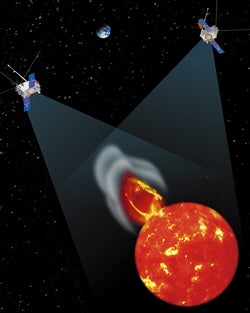For the first time, scientists can track solar storms from the Sun to Earth using the latest images from NASA’s twin Solar Terrestrial Relations Observatory (STEREO) spacecraft.
“The new view from the STEREO spacecraft will greatly improve our ability to forecast the arrival time of severe space weather,” says Russell Howard of the Naval Research Laboratory, Washington, the Principal Investigator of STEREO’s Sun-Earth Connection Coronal and Heliospheric Investigation (SECCHI). “Previous imagery did not show the front of a solar disturbance as it traveled toward Earth, so we had to make estimates of when the storm would arrive. These estimates were uncertain by a day or so. With STEREO, we can track the front from the Sun all the way to Earth, and forecast its arrival within a couple hours.”
NASA’s STEREO spacecraft were launched October 25, 2006, and January 21 completed a series of complex maneuvers, including flying by the moon, to position the spacecraft in their mission orbits. “Both the spacecraft and their instruments are in good health,” says Michael Kaiser, the STEREO Project Scientist of NASA’s Goddard Space Flight Center, Greenbelt, Maryland.
The new panoramic views are created by combining images from the SECCHI suite of telescopes on both spacecraft. They allow scientists to track a type of solar disturbance called a Coronal Mass Ejection (CME) from its birth at the Sun towards Earth. CMEs are violent eruptions of electrically charged gas, called plasma, from the Sun’s atmosphere. A CME cloud can contain billions of tons of plasma and move at a million miles per hour. As the CME cloud plows through the solar system, it slams into the slower solar wind, a thin stream of plasma constantly blowing from the Sun. The collision with the solar wind generates a shock that accelerates electrically charged particles in the solar wind, causing radiation storms that can disrupt sensitive electronics on satellites and cause cancer in unshielded astronauts.
Despite frequent observations over the last decade, many questions remain about CMEs, especially about how they travel through space. “Right now, we don’t know where CMEs slow down, why they slow down, or what forces cause them to slow down,” says Howard. “The new views from STEREO are like having a curtain lift from our eyes — they are extraordinarily instructive.”
As good as these images are, they are about to get even better. The two observatories will orbit the Sun, one slightly ahead of Earth and one slightly behind, separating from each other by approximately 45 degrees per year. Just as the slight offset between your eyes provides you with depth perception, this separation of the spacecraft will allow them to take 3-D images and particle measurements of the Sun. Scientists will use the 3-D views to discover new details about the structure of CME clouds, and to see how that structure evolves as the clouds move through space. The first 3-D views are expected in April.










